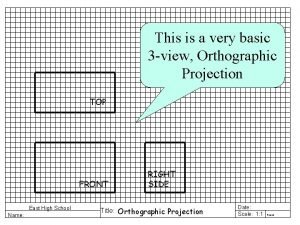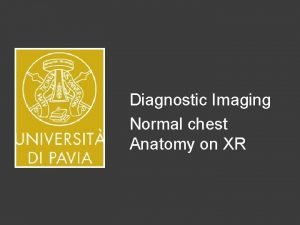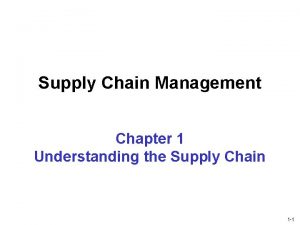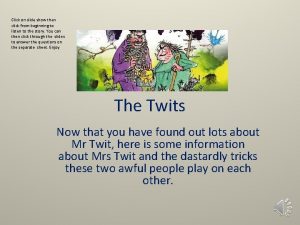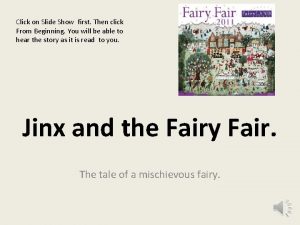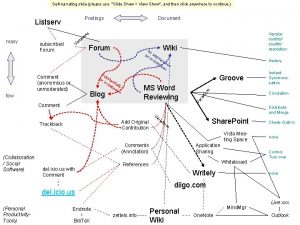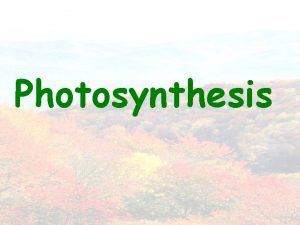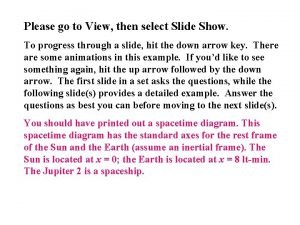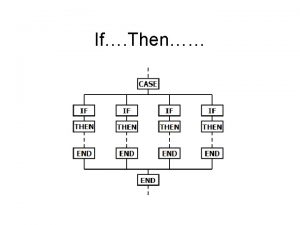Photosynthesis Tutorial Click on View then Slide show































- Slides: 31

Photosynthesis Tutorial Click on “View” then “Slide show” to view the tutorial. For some of the slides there animations so you must be in “slideshow” mode to view them. Try to answer the thought questions (in the orange boxes) before you move on to the next slide!

Photosynthesis Where does the energy come from that sustains all life? The Sun!! Well most of it anyway……

Summarizing reaction of photosynthesis! Sunlight CO 2 + H 2 O C 6 H 12 O 6 + O 2 DG = 686 kcal/mole Exergonic or endergonic? Energy releasing or energy requiring?

Photosynthetic organisms harness the sun’s energy to make organic molecules from inorganic sources. photoautotrophs They utilize sunlight for energy! They take in CO 2 and other inorganic nutrients and build complex organic molecules.

Some organisms create organic molecules from inorganic sources, but they don’t utilize sunlight! Chemoautotrophic bacteria Obtain energy through the oxidation of inorganic molecules. They take in CO 2 and other nutrients and build complex organic molecules. Thought question: Where have we encountered these types of bacteria during class?

Check out the undersea video of a hydrothermal vent ecosystem (click on this link). Chemoautotrohic bacteria form the base of the food chain in these environments… oxidizing inorganic chemicals from undersea volcanic vents. This energy is then used to create their own organic molecules. It is on these organic molecules that other animals around these vents feed!

Who photosynthesizes? Plants!

Who photosynthesizes? Marine and Freshwater planktonic algae (phytoplankton) Other algae (non-planktonic)

Who photosynthesizes? Cyanobacteria Found in the hot springs of Yellowstone N. P.

Anatomy of Photosynthesis in Plants Thought Questions: Where do each of the stages of photosynthesis occur in a chloroplast? Where are the photosynthetic pigments located?

Plant Cell Note that plant cells have both mitochondria for cell respiration and chloroplasts for photosynthesis!

Euglena a mitochondrion a chloroplast Phytoplankton also do both…!

Thought Questions: Why do plants/phytoplankton do both photosynthesis and cellular respiration? How are the two metabolic processes connected in plants? What else do plants do with the sugars constructed during photosynthesis?

Let’s start with where the food (sugar) is made in photosynthesis!

The Calvin Cycle Things to know about the Calvin Cycle for now… • Uses CO 2 • Uses ATP • Uses NADPH • Makes sugar (aka carbon fixation)!

The Calvin Cycle Where does the CO 2 come from? ? Describe these reactions. Use terms like SLP, energy coupling, REDOX, exergonic and endergonic!

Thought Question: How is the Calvin cycle the “opposite” of the Krebs Cycle?

The Big Picture ATP provides the energy NADPH provides high energy electron and H+ ions CO 2 provides the carbon and oxygen All the ingredients to make energy rich sugar molecules during the Calvin Cycle (a light independent reaction). aka Carbon Fixation

So where does the NADPH and ATP come from? Watch the following animation and describe in words…the answer to this question. In your explanation use the following terms: chemiosmosis; electrochemical gradient, potential energy, energy coupling; proton pump; active transport, passive transport. Use your textbook to help you with this!

NADP+ NADPH H+ ions ATP ADP P

Thought Questions…. Describe how these two processes are similar. Describe how these two processes are “the opposite” of one another.

Big Picture Question! The day before you head off to college for the year, you plant an Pine tree seed in your front yard. When you return at the end of the following summer, the tree has grown to a height of 1 meter! Where did most of the organic mass come from that resulted in the growth of this tree?

Photosynthetic pigments make up the “photosystems”

How plants harness energy from sunlight… Photosynthetic pigments Chlorophylls a – the “main” photosynthetic pigment Accessory pigments. . Chlorophyll b Carotenoids Thought question: What are the functions of accessory pigments?

A little bit about light…

Photosystems use some wavelengths of light but reflect others…

Thought Question: Plot the relative levels at which the different photosynthetic pigments absorb different wavelengths of light. Using this information • explain why green plants are green. • why deciduous plants change colors in the fall

Concept Mapping

Photosynthesis Concept Map • You may use any resources you have to do the concept map. • I encourage you to work together with your teammates to complete one map. • First put the terms on little pieces of paper or sticky pads and move the concepts/terms around on the page until you have them where you want them, then write them permanently to the page. • You may add a few terms/concepts from your research that your team feels are important or will help to tie the map together.

Good connecting phrases explicitly show terms are logically connected, highlight roles, functions or examples connecting the two concepts. A poor connection: NADH goes to Electron Transport Chain A much better connection: NADH carries high energy electrons to Electron Transport Chain

Pulling it all together! Construct a concept map of the following terms related to metabolism in plants Non-carbohydrate Organic Molecules Chlorophyll a CO 2 Cell Respiration Light Dependent Reactions Calvin Cycle (Light Independent Reaction) Sunlight sugars phytoplankton inorganic molecules O 2 chemoautotroph Photosynthesis Photosystems Carotenoids Chloroplast NADPH Thylakoid ATP Stroma ADP carbon fixation photoautotroph plants
 Click clever
Click clever Click clever click safe campaign
Click clever click safe campaign Clever click
Clever click Click clever click safe
Click clever click safe Heel and toe heel and toe slide slide slide lyrics
Heel and toe heel and toe slide slide slide lyrics Backstage view opens when you click the
Backstage view opens when you click the Unknown click
Unknown click Five r's of note taking
Five r's of note taking Custom slide show berfungsi untuk
Custom slide show berfungsi untuk Slideshow sabbath school
Slideshow sabbath school Naruto slidshow
Naruto slidshow During a slide show luis wants a picture to appear
During a slide show luis wants a picture to appear Identifying qualitative graphs answer key
Identifying qualitative graphs answer key Show the detailed abstract view of dsm
Show the detailed abstract view of dsm Slide and divide factoring
Slide and divide factoring Slide 2 tutorial
Slide 2 tutorial Multiple view geometry in computer vision.
Multiple view geometry in computer vision. Top view is directly above the front view
Top view is directly above the front view In case of half sectioning, of the object is removed.
In case of half sectioning, of the object is removed. Sectional view drawing
Sectional view drawing Example of full section
Example of full section Worms eye view shot
Worms eye view shot End view
End view Orthographic engineering isometric drawing
Orthographic engineering isometric drawing For the view create view instructor_info as
For the view create view instructor_info as Simple view and complex view
Simple view and complex view Simple view and complex view
Simple view and complex view Simple view and complex view
Simple view and complex view Partial view controller
Partial view controller X ray indication
X ray indication Cycle view and push pull view
Cycle view and push pull view Component of operating systems
Component of operating systems

















